
by Sandy | Aug 11, 2018 | Personal Expression
In a nut shell – people won’t talk to you. That’s the 5 word version of what can happen but let me elaborate.
I had a wonderful conversation today. The conversation was in a social setting but the stated purpose was to talk about the Enneagram. It is my version of heaven on earth – exploring the wonder of our Inner Landscapes.
That is until the “thing” appeared.
The “thing” is the guarded response which people do when they try to reply without giving themselves away. They edit their speech to eliminate any words or phrases that they recognize as type specific. It is as if they see you as a mind reader able to observe what is going on inside – inside THEM!!!.
Not only can’t I read minds – I am not interested. It is the energy dynamic between people, the thrust and parry, the synchronicity that excites me. So talk away…you, my dear, are simply fascinating.

by Sandy | Aug 7, 2018 | Personal Expression
The fallacy of going it alone
Independence has often been heralded as an essential quality – overtly for entrepreneurs and as a sub-text for others such as high performers on their way up the corporate ladder similarly for senior leaders. It is part of a particular mindset that one can associate with words such as ‘go-getter,’ ‘self starter,’ ‘fast track,’ and that oh so overused word ‘maverick.’
The Reiss Desire Profile of Motivational Tendencies, an assessment of 16 core motivators, helped me to see the role that Independence plays in my own behaviour. The old adage about your biggest strength if overused becomes a weakness holds true when it comes to Independence. Since my pattern is to be unconscious about asking for help, I need to be intentional about creating ways to reach out to others.
Changing Landscape
Everywhere you look, you find moment to moment examples of the increasing levels of complexity that face us on a personal and organizational level. You have to navigate through new technologies that impact how we communicate and process data. Even if you are a techie there can be a certain fatigue or unnatural over-excitement and dissatisfaction that come from being on this treadmill. Client needs are continually expanding while resources are often dwindling. There comes a point where you realize that you cannot do it all by yourself. Even if you could, you run the risk of being blindsided that you didn’t anticipate.
An important part of your strategy
Here’s where “reaching out” steps into play a critical role. Who do you turn to when you need some input that you can trust? Before you get to the point of overwhelm there is tremendous value in being intentional in creating a community so that you are not working in isolation. I don’t have one definition to offer for community but I have a list of examples of places where I reach out. You might find an idea to try.
Mastermind: Typically of group of 8 to 10 from diverse business backgrounds that meet once a month to talk about their business challenges.
Trusted Advisors: People who know your work as a result of collaborations or parallel interests and are open to being in conversation with you about things you may be considering. They may or may not be friends but they are people that you can trust and who you know will give you the straight goods and who also appreciate your support and input.
Professional Associations: Meetings and conferences offer learning opportunities
Virtual Communities: Online discussion forums where you can get instant input often from a global community
Learning Community: These may take various forms. I have two groups that I value. One is a group that has continued to meet 4 years after a coach training to share best practices and new learning. The other is within the consulting company where I am an associate where professional development and ongoing group learning is an embedded value and practice.
Board of Directors: An idea that is not just for corporations – When you are considering a major shift think about convening a group of knowledgeable individuals from various arenas to guide you. You may be surprised at just how willing people are to help if you approach them in the right way.
Your clients and customers: Perhaps your greatest source of help, support and information if you ask.
Before you reach out to others consider how to truly benefit from this approach:
- Set aside the role of expert
- Listen objectively without need to judge or justify
- Allow space for input to percolate and for new ideas to emerge
- Try out the ideas that a fit before you have every wrinkle resolved. Senge, Scharmer, Jaworski and Flowers espouse the value of prototyping in their work “Presence.” You will know quickly enough whether to adjust or abandon an idea.
Reaching Out has beneficial side effects:
Not only do you get a clearer perspective on the big picture and pieces that may be blind spots for you, but also in the long run you end up with a better result than you could have by clinging to “going it alone”. There is also a paradox at play. When you are honest in bringing a genuine question to the table it builds trust and confidence in your capabilities rather than diminishing your position.
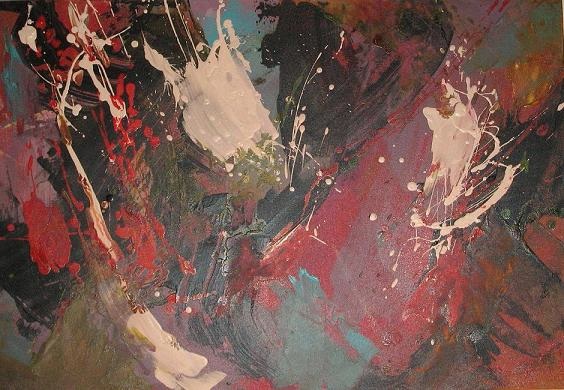
by Sandy | Jul 15, 2018 | Best Practices, MBTI Facts, Personal Expression
Imagine seventeen creative people in one confined 20 x 30 foot space for five days in a painting workshop exploring non-objective painting. Interestingly non-objective painting is a very personal and internal experience. My perspective on it is that you have to know who you are, know how to handle the materials and then surrender to the process – letting it flow through you. It is not for the timid or faint of heart.
Given that context, imagine the effect of people having animated (in other words LOUD) conversations about topics both trivial and profound on those engaged in this deeply challenging process and then consider what that might be like for an Introvert.
Here is my observation of 3 Introverts and how they coped in this scenario.
Introvert #1
This person was the only person who actually disclosed their type as INFP. They must have been out of preference in one area on the Extraverted side because they were a “frequent talker” and one of the more vociferous people in the group. How did they handle their need for Introversion? At some point earlier in the day than most, they were simply DONE for the day. Their energy had run out and they left the workshop early in order to refresh or regroup for the next day.
Introvert #2
As well as there being an on-going flow of conversation, there was also music which was mostly jazz or classical. One person was really suffereing as a result of all the external stimulation, but didn’t say anything until Day 4 when they simply couldn’t take it anymore and made a request to the teacher to ask for quiet. Unfortunately for them that was only a temporary respite as people slowly returned to their chatter. I was close enough to hear the moans of frustration that quietly punctuated the air – more like commas or parenthesis than exclamation marks. A second request for quiet was never made.
Introvert #3
This person had a whole strategy in place. They chose a workspace that was at the end of the row of tables closet to the open unused space and facing a wall. They also had an ipod in place for most of the workshop. Not only did they get to listen to sounds of their choosing but people did not approach them for idle conversation. It was as if they created a bubble for themselves within the very active environment. In addition they painted through the lunch break while the rest of us were gathered at a group table for more chat. When it came time for demos or critiques they were fully present and contributing. They were very intentional about managing their energy and yet engaging enough to be social.
This third example models being aware of your needs and taking responsibilty for having these met in a way that does not take away from the experience for themself or others. While I think that an ipod is a brilliant idea, it is for each person to assess the situation and have a plan for coping in the best way possibility. It is not necessarily about the mechanism – Intentionality is key.
FYI – here a clip of my class
<iframe width=”560″ height=”315″ src=”https://www.youtube.com/embed/_hNFDdoi75Y” frameborder=”0″ allow=”autoplay; encrypted-media” allowfullscreen></iframe>
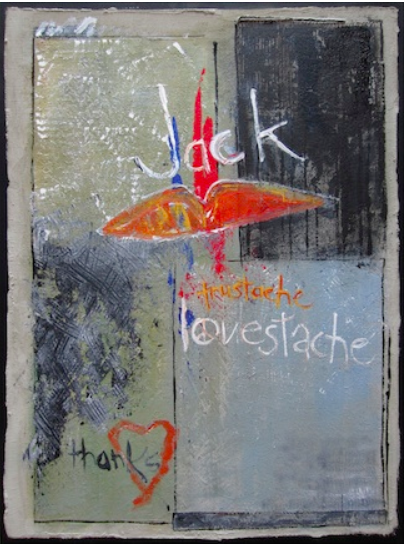
by Sandy | Jul 5, 2018 | Personal Expression
I painted this painting in response to the death of Jack layton, the leader of the New Democratic Party. It is not really a political painting. I like to think (no ego LOL) that it is about something larger. When Jack died there was a spontaneous outpouring from people from across Canada, from across the globe, from across income levels, from across ethnic, age or educational backgrounds and from across political affiliations.
What were they responding to? I had the thought that people were responding to the loss of someone with undeniable integrity. Here was a man who had a consistent and persistant message for years and years. He wasn’t angry or arrogant but outspoken and willing to educate anyone about the elements that were creating the current situation.
In a time when we are skeptical about our politicians and their motivations, Jack was a man we could trust. You might not like his politics or even the way he presented his message, but there was something that everyone recognized in him as being of value.
This was painted the summer Jack died and almost a year later – a week or so from the first day of Spring, someone pointed out that she had seen the graffiti “Trustache” which rhymes with Jack’s ever present moustache and read it differently. What she saw was TRUST ACHE and thought that the painting spoke to the “ache” that the voting population has for being able to TRUST our politicians and each other.
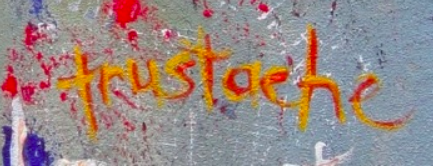
Some MBTI types use metaphor and even think in metaphor. This particular interpretation really touched me. Typically I say that I paint rather than call myself an artist, but having someone else see something deeper in your work is in the territory of art and what art contributes to the human experience.
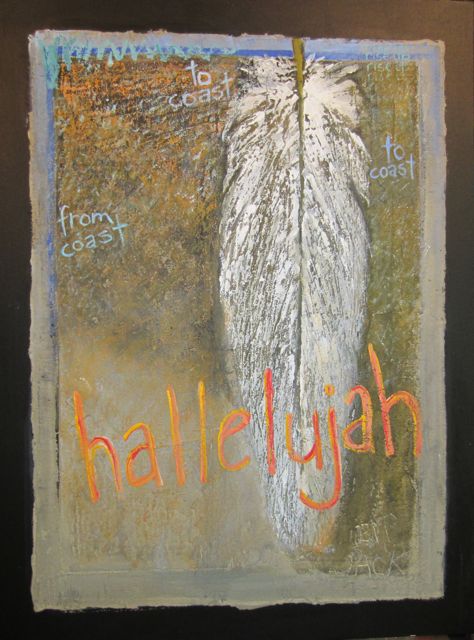
by Sandy | Jul 3, 2018 | Personal Expression
What’s next? What’s possible? Where is the growing edge? How can I play there?
These are the questions that motivate me and make me want to grow and that fuel my creativity. This is not the path that all artists take but it seems to be mine.
The spark for this painting came from committing to a show in October that will feature the work of artist members of Verity, a women’s club/haven/community in Toronto. Since each participant will have 3 pieces, this became an opportunity to try a new direction or a least a new medium.
That meant … cement.
Cement meant Andrew Crane.
I know Andrew because I follow him on Facebook and have been continually inspired and intrigued by his work.
Thus began a cycle of trusting and reaching.
Trust – if Andrew could do cement I could do cement.
Reach – if a Google search for “how to” use cement on canvas turned up Andrew Crane as the only resource, I could dare to ask him for advice.
The reward – an encouraging response from Andrew with complete detailed steps.
Trust – that I could find the equivalent of the materials that Andrew was using in the UK in cottage country Ontario.
Trust – that I could find my way not only with the material, but with what I wanted to say – surely I needed something new and significant to say.
After several rounds of practice on recycled boards and old canvas, I had a sense of cement but was at a loss for what I wanted to express.
Reach – this was a combination of letting things come to me and exploring out in the world so that there were points of contact for subject matter to arise.
Trust – the thing was that I trusted that the attraction to the immediate and very raw aspect of cement was bigger than my not knowing what to do with it – just yet.
Reach can be described in this context as trusting the process – Was it relevant that I was very shocked and saddened by the untimely death of the leader of the NDP, Jack Layton – right when I was seeking meaningful expression? On Facebook I followed the postings of the chalk homage at City Hall, the outpouring of genuine affection from across Canada from people of all ages, creeds and political affiliations. I wept through the televised funeral.
BINGO – I needed to to harness my own raw emotion and that of the people I was responding to on Facebook and raw cement provided the perfect medium.
Even when I realized that I had mistakenly quote Shawn Atleo as saying “from sea to sea to sea” during the blessing at the service for Jack, I trusted that I could redo the background in order to write ” from coast, to coast to coast. This trust comes from hours and hours of applying paint. If I messed up I know that I can keep going and eventually turn the corner back to something I like.
I am content with what I have done – I trust it to be recognized or not and it doesn’t matter. It feels good that I am not concerned with the opinions of others – at the moment. They may not dig cement on their walls and that’s OK. I get it and have an inner chuckle at the multiple layers and hidden meanings at play in my mind.
Pure cosmic fun!!! That is a reward worth appreciating.
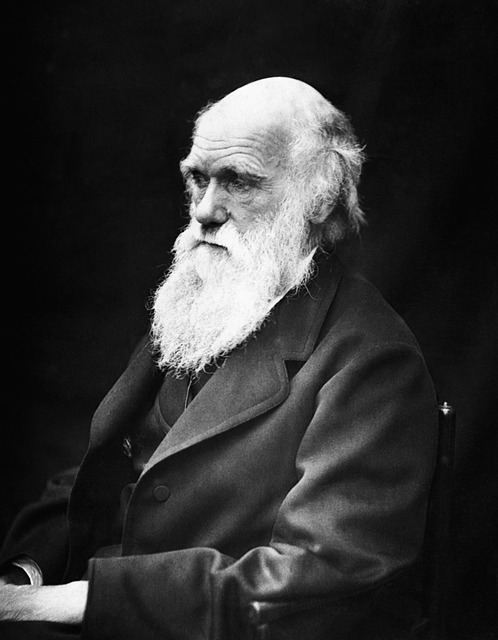
by Sandy | Feb 9, 2018 | Personal Expression
It is almost 10 years passed the 200th anniversary of the birth of Charles Darwin. I was aware of it but hadn’t given it any particular attention until I was inspired to do some reflecting by an interesting exchange on Twitter.
Ken from NYC aka @holymully “Your only obligation in any lifetime is to be true to yourself.” – Richard Bach (my quest indeed – why is it a challenge?)
holymully @sandymcmullen The challenged to being yourself is explained in Darwinian terms as “survival” games. 2 be real self threatens survival
I don’t know that I have reached any conclusions even though I have been mulling this over for a few days nevertheless here is what I have “found” so far.
I suppose we can get closer to being our real selves when we are relaxed and have no demands impinging on us from the external environment. These occasions may happen at times such as vacation. When there are no demands from the external world being ourselves may be more closely aligned with our “real” or natural state.
Darwin observed the Natural world in order to identify and record the characteristics that allowed species to survive in different environmental conditions. As environmental conditions change the species with the characteristics that increase their chances for survival remain while other species fail to survive.
In the struggle for survival, the fittest win out at the expense of their rivals because they succeed in adapting themselves best to their environment
The natural world as we know it in our daily lives has many dimensions – environmental, economic, social and emotional. There are certain personality types that are naturally hardy and can adapt to upheavals in circumstances in a timely manner. They are resilient and bounce back from whatever shifting circumstances happen to dish up. This naturally hardy type may be more the exception than the norm.
In this current economic downturn: for example, many people are feeling at risk. They feel pressure to adapt their behaviour, their beliefs indeed their very sense of themselves. If they don’t adapt they may not survive and questions like “who am I really” become secondary to questions like “how am I going to feed my family?”.
The one thing that we can count on is that things do not remain static. Change is inevitable whether it is positive or negative.
I would like to suggest that we do not need to give up who we are in order to survive. Yes we may need to make changes in the way we do things but we have resources and capabilities to design an approach that is ecological to the larger system and to our own integrity. Before we know where we need to adapt we need to have a realistic picture of “what is” – the reality of the moment. We also need to know who we are (our strengths and our limitations) in order to know where we need help.
Darwin observed and observed in order to know the true nature of the natural world. In order to know our true nature, we can focus on becoming better and better at being observers of the flow of our moment to moment reality. Not everyone is committed to the rigor of this way of knowing ourselves. Employing a selection of personality assessment tools ssuch as the MBTI , the Enneagram or the Reiss desire Profile can help provide a lens to support our journey toward self knowledge.
The clearer I am about what I can do and cannot do the clearer I can be about what next steps I need to take. In the world of flora and fauna “natural selection” may prevail. We have the opportunity to use whatever wisdom we have in order to be intentional about how we interact while still respecting that we are part of a living system. Indeed, the paradox of knowing and accepting our limitations and reaching out to others to get help may be just the thing that makes room for adaptation (transformation) to occur.
Here’s a thoughtful response to this post:
Hey Sandy:
Sorry it’s taken so long to respond but its been one of those months of deep introspection for me – inspired, in part, by your post. (Thanks for the rest of your gifts that provoked reflection this year too, btw)
As a Virgo with a Thinking preference, being analytical and ‘knowing oneself’ is very important. I subscribe completely to the notion that “the unexamined life is not worth living”.
Knowing oneself is one thing, however being ‘true’ to oneself, as you so rightly point out, is a challenge. Environmental conditions (economic, social and emotional) often pressure us to change in order to survive. How can we do that with integrity? How can we adapt with awareness and knowledge and yet stay “true to ourselves”?
I think the crux lies in understanding ourselves as ever evolving, ever adapting organisms. In Darwinian terms, we’re not far out of the trees physically but socially we’ve made considerable “progress”. As emotional beings, on the other hand, we still have some considerable way to go, imho.
Our emotional life often leaves us with a bunch of past experiences through which we filter current events – we accumulate insecurities and fears and needs etc. that inform our perception of “reality”. Often we recognize that the feelings we experience aren’t rational but sometimes they’re so intense, they’re hard to deal with. The temptation is to throw our hands up and say, ‘That’s who I am’ – as if capitulating to our fears and insecurities is somehow a display of integrity. It’s nothing less than an abdication of responsibility to do the hard work. In that sense, I think we need to give up “who we are” in order to survive (not physically but mentally, emotionally, spiritually)
For me, the key is to acknowledge that between stimulus and response; we have a choice. It is within our power to change our emotional response to a situation. It’s not easy; it takes effort but as you point out “we have the opportunity to use whatever wisdom we have in order to be intentional about how we interact while still respecting that we are part of a living system”
Finally, thanks Sandy for your gentle guidance and mindful mentorship.
hugs
John







